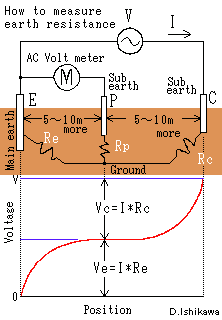Measurement of ground resistance with earth resistance meter
If it leaves the earth point by 5-10m or more in radius, the method of measuring the ground resistance with an earth resistance meter on the market uses the thing with a little influence of the current with the earth.
Principle of operation of earth resistance meter

It is an earth that E starts measuring by the measuring method of a left ground resistance. Supplementary earth stick P is driven in a point 5-10m or more away from this earth and supplementary earth stick C is driven to a point 5-10m or more on the same extension line away in addition.
It is the alternating voltage between E and C V is put and current I is thrown. Re, Rp, and Rc are the ground resistance in each earth pole. The voltage between earth pole E and P Ve is measured with AC voltmeter M. Because the current doesn't flow to Rp at this time, this resistance is irrelevant.
Because it is Ve = I*Re ,It becomes Re = Ve/I
It is possible to measure it actually only by reading the numerical value of the earth resistance meter even if such a calculation is not done.
If it is not a point that the voltage doesn't change even if P point moves the place in the place a little by the potential of the earth in the voltage distribution of this figure, an accurate measurement cannot be done. The reason for the extent of the impact of the ground resistance of Re and Rc because is that it is about 5-10m or more ..the earth point... Separating the supplementary earth stick more greatly than the earth point becomes important when the resistivity of the soil is large.
Measurement of ground resistance with earth resistance meter

This photograph is a transistor type automatic operation earth ohmeter of PDR-100 analog of Sanwa. The earth resistance measurement method is three electrode method or two electrode method of the constant-current system.
Three electrode method is a measuring method by the above-mentioned theory. The leftmost terminal E of a left photograph is connected with the earth that measures the ground resistance. There are terminal P and terminal C for the supplementary earth pole in the right.
Two electrode method is short-circuited of the terminal of C and P so that an already-known earth is near by the measuring method at being, measures the resistance between terminals E by the ground resistance, and subtracts already-known earth resistance.
An accurate measurement is possible, and it still uses it for the theory in the active service because it faithfully measures it though it is an old earth resistance meter. The range of 0-1k OHM can be measured.
When the electrical work trader is registered in administrative divisions, the earth resistance meter is one of the necessary meters. Besides, the circuit meter (tester) and the megohmmeter are also necessary.
Reason to use AC for earth resistance measurement
Is the measurement of the ground resistance not DC and why measured by the AC? It is because the generation of the battery with the polarization action by electroanalysis and different kinds of earth poles influences it in DC.
That is, it becomes difficult to flow gradually in the current even if a similar thing to electroanalysis of water and salt water happens by the moisture of the soil, the bubble of hydrogen, oxygen, and chlorine is generated by the electrode (polarization), and a lot of currents flow first if it measures it in DC. With this, whether when I may measure the current is not understood. Resistance changes. ,in a word,
Moreover, an actual earth uses iron, uses the carbon, and is a board of galvanizing though there might not be problem if the sheet copper fellow is handled to the earth pole and the auxiliary pole. If it is the different kind of material, the battery is generated only with it. The current flows only with the battery though DC is not added in a word. Then, it is a thing that it depends in the direction of the DC added by the measurement and the current value is different. With this, the error margin is given to the measurement of the ground resistance.
If it is an AC, there is no influence like the above-mentioned and an accurate measurement is possible.